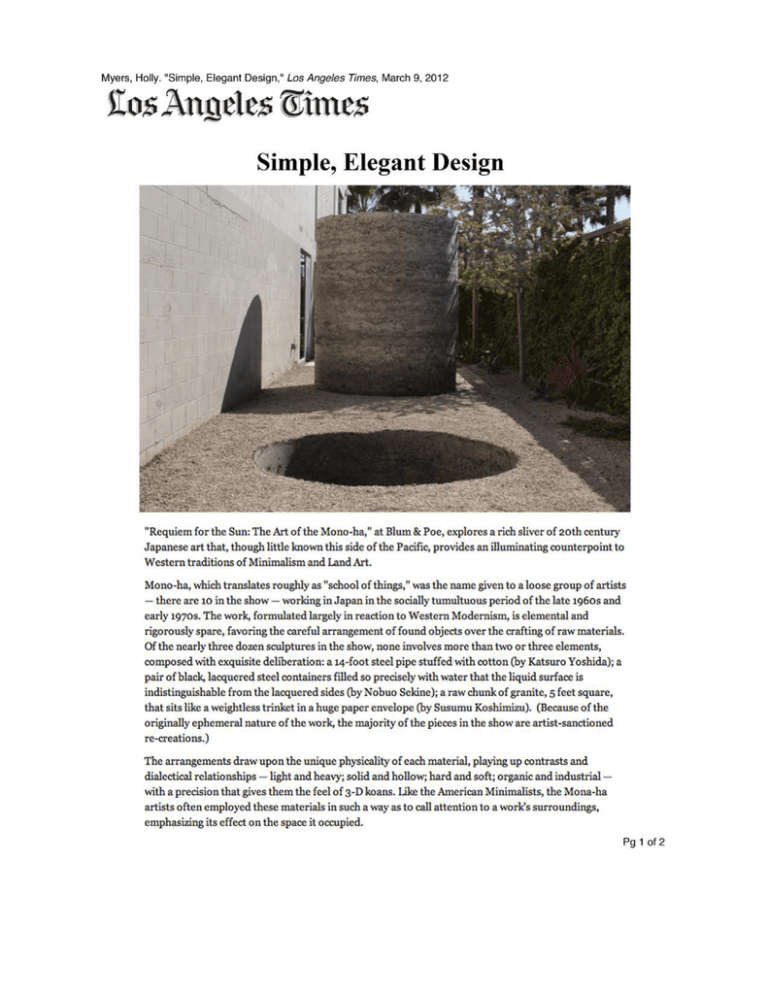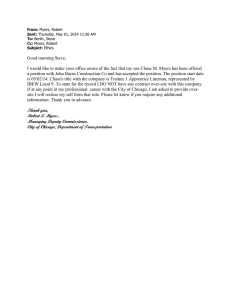Simple, Elegant Design
advertisement

Myers, Holly. "Simple, Elegant Design," Los Angeles Times, March 9, 2012 Simple, Elegant Design "Requiem for the Sun: The Art of the Mono-ha," at Blum & Poe, explores a rich sliver of 20th century Japanese art that, though little known this side of the Pacific, provides an illuminating counterpoint to Western traditions of Minimal.i sm and Land Art. Mono-ha, which translates roughly as "school of things," was the name given to a loose group of artists - there are 10 in the show - working in Japan in the socially tumultuous period of the late 1960s and early 1970s. The work, formulated largely in reaction to Western Modernism, is elemental and rigorously spare, favoring the careful arrangement of found objects over the crafting of raw materials. Of the nearly three dozen sculptures in the show, none involves more than two or three elements, composed with exquisite deliberation: a 14-foot steel pipe stuffed with cotton (by Katsuro Yoshida); a pair of black, lacquered steel containers filled so precisely with water that the liquid surface is indistinguishable from the lacquered sides (by Nobuo Sekine); a raw chunk of granite, 5 feet square, that sits like a weightless trinket in a huge paper envelope (by Susumu Koshimizu). (Because of the originally ephemeral nature of the work, the majority of the pieces in the show are artist-sanctioned re-creations.) The arrangements draw upon the unique physicality of each material, playing up contrasts and dialectical relationships - light and heavy; solid and hollow; hard and soft; organic and industrial with a precision that gives them the feel of 3-D koans. Like the American Minimalists, the Mona-ha artists often employed these materials in such a way as to call attention to a work's surrowtdings, emphasizing its effect on the space it occupied. Pg 1 of 2 Myers, Holly. "Simple, Elegant Design," Los Angeles Times, March 9, 20 12 In a canonical work by Lee Ufan, the Korean-born artist who became the movement's central theoretician, a large stone rests on a plate of glass that's been shattered by its weight. In Kishio Suga's "Infinite Situation II (steps)," a gallery stairwell has been filled with sand and graded into a smooth, even incline - a gesture that gently but decisively eradicates the function of the architecture, underscoring the tenuousness of the relationship between the built and the natural environment. The best of the works are stunning in their simplicity. N obuo Sekine's "Phase - Mother Earth," the piece that is considered to have marked the birth of the Mono-ha in 1968, consists of nothing but a cylindrical column of compacted dirt, roughly 9 feet tall and 7 feet in diameter, sitting alongside a hole of precisely the same dimensions dug in the gallery's narrow garden. Curated by Mika Yoshitaki, "Requiem for the Sun" is a beautiful exhibition, intelligently conceived and elegantly installed - one that offers an inadvertent nudge to L.A museums, now that Pacific Standard Time is winding to a close, to raise the bar on their international programming. Pg 2 of 2



